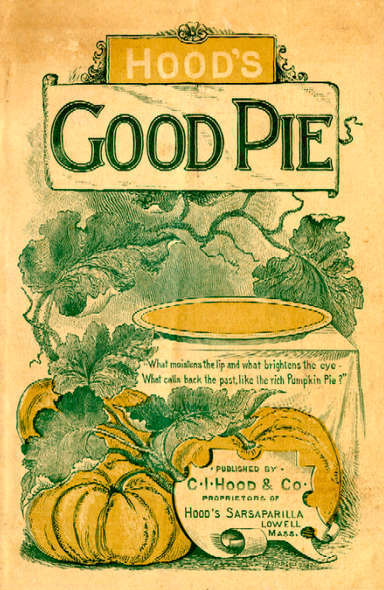|
Hood’s Good Pie, 1890. Warshaw Collection of Business Americana: Cookbooks. Archives Center, National Museum of American History, Smithsonian Institution.
|
Good Pie
Influenced by the powerful lobbying efforts of Sarah Josepha Hale, President Lincoln declared Thanksgiving a national holiday in 1863, during the midst of the Civil War. Thanksgiving was different from other national holidays in its reliance on food, nature, and traditions connected to the land.
Pumpkin was a key ingredient in this new national ritual. Adding sugar and spices made eating pumpkin not only a symbolic act but a pleasurable one, which by extension sweetened the romantic ideas about virtuous rural life inscribed in the vegetable. The 1890 cookbook “Hood’s Good Pie” expresses how these two phenomenon—the ideological and the physiological—work together. The cover depicts three large voluptuous pumpkins reaching up their broad leafy vines and wrapping themselves around a baked pumpkin pie set on a linen-covered table. Whittier’s line, “What moistens the lip and what brightens the eye—What calls back the past, like the rich Pumpkin pie?” serves as a caption. In large bold letters across the top of the cover is the title, “GOOD PIE,” signifying the tasty flavor, of course, but also the benevolent meanings and values the pie possesses. It offered not just nutritional enrichment but, as the ad suggests, cultural enrichment, too. |

|
|
- Home
- About the Book
- About the Author
-
Online Exhibition
- Just Another Squash: 12,000 BCE to 1600
- From Pumpkin Beer to Pumpkin Pie: 1600 to 1799
- The Making of a Rural New England Icon: 1800 to 1860
- The Pumpkin and the Nation: 1861 to 1899
- Americans Celebrate the Fall Harvest with Pumpkins: 1900 to 1945
- The Changing Nature of Pumpkins: 1946 to the Present
- The Changing Nature of American Rural Economies: 1946 to the Present
- Events
- Contact

